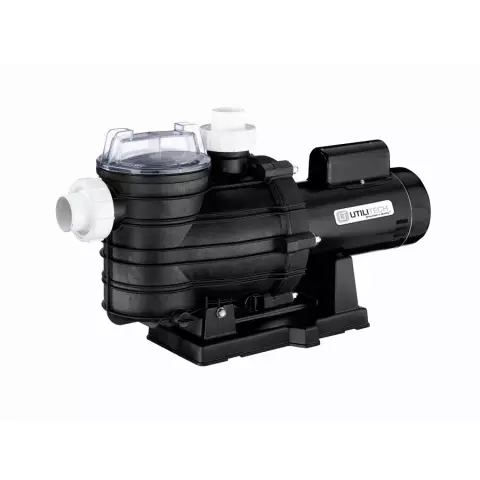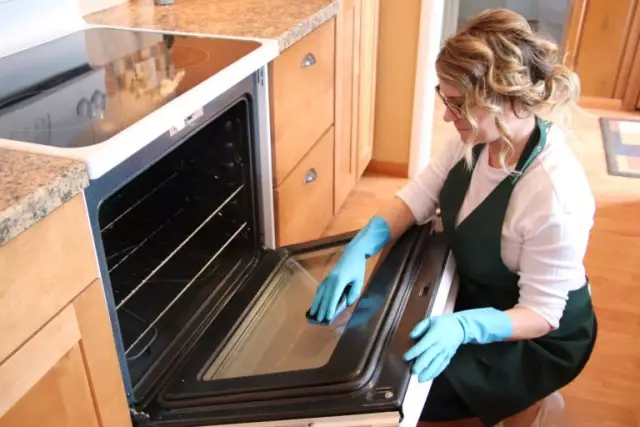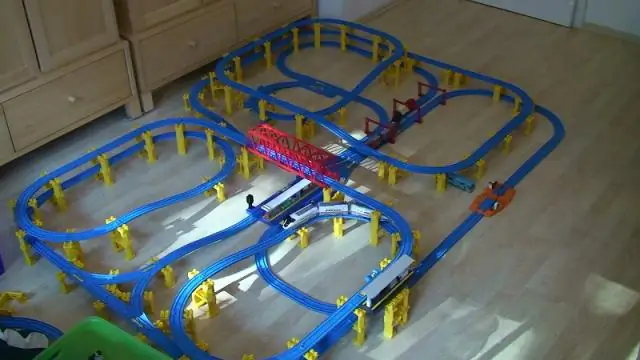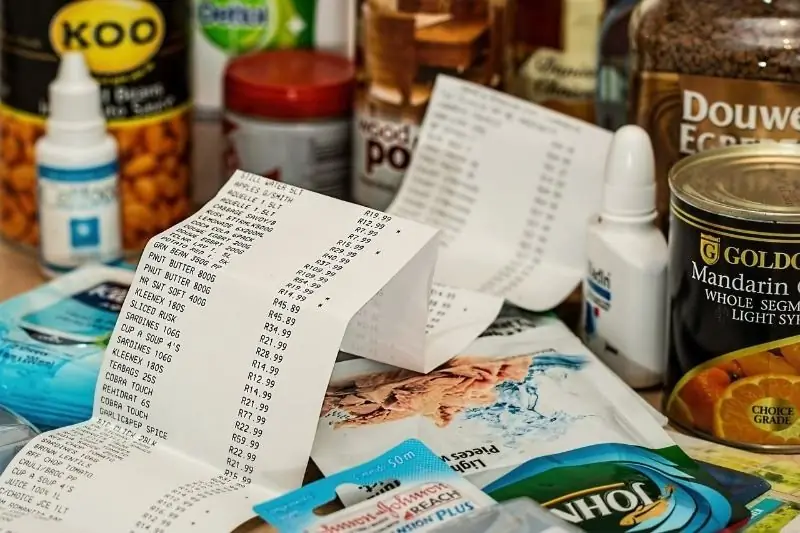
Table of contents:
- Author Bailey Albertson [email protected].
- Public 2023-12-17 12:53.
- Last modified 2025-01-23 12:41.
How to repair and clean a pool on your site

If you have a frame, inflatable or stationary pool on the territory of a summer cottage or a country house, then sooner or later it will need repair and cleaning. It is very important that the water in it is always clean, and the frame does not leak. If you correctly and regularly monitor the condition of the pool structure and water, it can serve you for many years.
Content
-
1 Pool repair and decoration: step by step instructions
-
1.1 Plastering a concrete pool
- 1.1.1 Plastering on a grid
- 1.1.2 Video: DIY plaster on a grid
- 1.1.3 Applying the adhesive
- 1.1.4 Video: pool renovation
-
1.2 How to paint a pool
- 1.2.1 Reconstruction of a metal outdoor pool
- 1.2.2 Video: painting a metal pool
- 1.2.3 How to paint a concrete pool
-
-
2 How to seal an inflatable pool: different ways
- 2.1 Video: how to glue - instructions
- 2.2 Film repair
-
3 DIY cleaning: step by step instructions
- 3.1 From greens with a vacuum cleaner and chemicals
-
3.2 From plaque and rust
3.2.1 Video: Algae Removal
- 3.3 From nematodes
- 4 How to care and use your home pool
Pool repair and decoration: step by step instructions
A concrete pool definitely requires finishing work. This is not an easy task on which the efficiency of future operation of the structure depends. The inner surface is regularly exposed to water and high hydraulic stress. Therefore, for finishing the pool, it is necessary to choose only high-quality materials, such as: PVC film, tiles or mosaics. The implementation of a certain technology of work will help to obtain a reliable and high-quality bowl.

Stationary pool on the site of a country house
Plastering a concrete pool
The concrete pool bowl does not turn out to be perfectly flat, therefore, it requires subsequent leveling of the walls. In this case, you can use two methods of plastering: mesh and glue.
- Plastered walls and bottom must be free from defects. A minimum unevenness of 4 m 2 with a size not exceeding 1 mm 2 is allowed.
- The plastered bowl must not have cracks, which in the future may cause loss of tightness.
-
The maximum deviation in the evenness of the walls and bottom should not be more than 1 mm per 1 meter.

Pool creation scheme The scheme of creating a pool with lining
Plastering on a grid
Plastering on a grid is carried out using simple cement-sand mortars. But since such materials cannot provide reliable adhesion to the surface, therefore, first it is necessary to fix a special metal mesh, and the loan to begin work on plastering the walls and bottom of the pool. This method is used before the tiles are laid.
Materials and tools
- Water-repellent cement mixture, sand.
- Metal, glass or synthetic mesh.
- Anti-corrosion agents.
- Spatulas.
- Level, rule.
- Anchor.
- Primer.
- Roller.
Work stages
- We thoroughly clean the surface of the walls and bottom of the pool from dust and debris. Apply a layer of primer with a roller.
-
Using anchors or dowels, we fix the metal or polyurethane mesh around the entire perimeter of the pool. We fix it in a checkerboard pattern with a step of 30-50 cm.

Plaster mesh Polyurethane mesh for plastering
-
Mix the plaster in a large building container, following the manufacturer's instructions.

Plaster for wet surfaces Plaster for wet pool surfaces
-
Apply the starter plaster in an even layer with a spatula and let it dry for about 24 hours.

We apply plaster Putting plaster on the mesh
-
Then we once again prime the surface of the pool and apply a finishing layer, removing the defects of the first layer and adhering to strict geometry.

Priming the walls of the pool We prime the walls of the pool again
-
After the mortar has dried, we carefully rub the surface of the walls and bottom. Let the entire layer of plaster dry well.

Perfectly plastered pool Perfectly plastered concrete pool
For plastering the pool, it is recommended to use waterproof cement-based mixtures
Video: DIY plastering on a grid
Adhesive application
To firmly fix the adhesive to the concrete base, it is necessary to carry out high-quality preparation. Before applying the adhesive plaster, it is necessary to treat the surface with a special impregnating compound, which penetrates deeply between the smallest concrete particles, reduces its porosity and makes the surface of the walls waterproof. Also, the impregnation increases the adhesion of the plaster to the concrete.
Materials and tools
- Adhesive impregnation based on acrylic resins, urethane and other polymers.
- Adhesive composition.
- Spatulas.
- Roller.
- Vacuum cleaner or compressor.
Work stages
- We clean the pool bowl from dust and remaining construction debris. For this, you can use a vacuum cleaner or compressor.
-
Observing the instructions, carefully treat the entire perimeter of the pool bowl with an adhesive solution and let it dry completely.

Cleaned pool surface Cleaned and treated concrete pool surface
-
Apply a layer of leveling mixture, evenly distributing it over the entire surface.

Apply a leveling mixture Apply leveling mixture to the pool walls
-
After the solution has dried, we eliminate all defects and irregularities.

Surface grinder Pool grinder
-
We apply the finishing composition of the solution and carry out the final grouting of the surface. Leave it to dry completely. The instructions indicate how long the mixture should dry, as usually the time depends on the thickness of the applied coating.

Perfectly flat pool surface Perfectly flat surface of a plastered pool
After the plaster is completely dry, it is necessary to cover the pool walls with a special waterproofing mixture, which will significantly increase its water-repellent characteristics

Waterproofing impregnation for the pool
Video: pool renovation
How to paint a pool
Any pool, after a certain time, needs reconstruction and renovation. For this, you can use a variety of materials. Since outdoor pools can be made of a wide variety of materials, they are painted with special water-repellent paints.
Reconstruction of a metal outdoor pool
Metal is susceptible to corrosion, and even more so an outdoor pool, which is always in an open space and comes into contact with water. In any case, once every few years, it is necessary to paint the walls and the bottom of the structure, since the old paint tends to peel off and crumble. In order for the metal pool to serve for many years, it is necessary to monitor it and paint it regularly.

Metal pool before restoration
Materials and tools
- Grinder and petal discs.
- Mask and goggles.
- Brushes.
- Roller.
- Anti-corrosion agent.
- Water-repellent acrylic paint.
Stages of work
-
First, we clean the walls and bottom of the pool from old paint. We do this with a grinder with petal cleaning wheels. Thanks to this, the new paint will adhere to the metal much better and will last longer.

Sweep circles Grinding wheels on the grinder
-
During work it is necessary to wear a mask and goggles, as dust from old paint can get into the eyes and respiratory system.

Mask for work Grinder mask
-
After the paint is completely removed from the metal surface, it is necessary to treat the entire perimeter with an anti-corrosion agent.

Removing old paint Removing old paint from the surface
-
To paint a metal pool, you must purchase a waterproof paint. But if necessary, you can use ordinary weather-resistant enamel. It will also last for several seasons.

Pool paint Metal pool paint
-
We begin to paint the pool, passing in hard-to-reach places with a brush. We paint over corners and joints especially carefully.

We paint over hard-to-reach places Paint over hard-to-reach areas of the pool
- We paint the walls and the bottom with a convenient roller. Multiple layers can be made if necessary.
- We leave the paint to dry. To prevent leaves or other debris from getting on it, cover the pool with plastic wrap.
-
After 12 hours the paint should dry and the pool can be refilled with water.

Renovated swimming pool Refurbished metal pool
Video: painting a metal pool
How to paint a concrete pool
Usually outdoor pools are made of concrete. And, of course, they need finishing work. Today, there are waterproof rubber paints that are great for painting concrete surfaces.
Materials and tools
- Primer.
- Putty.
- Antiseptic.
- Rubber paint (brands of manufacturers: VD-AK-425, Ecoroom, SuperDecor, VDAK-103, F31-Optimist).
- Roller.
- Brushes.
- Grinder.
Stages of work
- Before painting, we putty the concrete surface of the pool and carefully grind it.
-
We process the walls and bottom with a primer. Let it dry well.

Wall treatment with a primer Treatment of pool walls with a primer
-
We degrease the concrete walls and the bottom, and then sand it again. We treat with antiseptic agents. To reduce paint consumption, all preparatory work is required.

Grinder Pool grinder
-
We mix the paint well so that it acquires a uniform consistency.

Rubber paint Swimming pool rubber paint
-
Apply paint on a dry surface with a roller or spray. When working with a spray, it is necessary to ensure that the temperature does not drop below + 5 ° C.

Apply paint to the pool surface We apply paint to the surface of the pool and distribute it with a special tool
-
Each subsequent layer is applied only to the dried paint.

Pool dyeing Concrete pool painting
Rubber paint is an economical material, therefore, for painting a concrete coating in 2 layers, the consumption will be 400 grams per 1 m2
In order for the paint to serve for many years, it is necessary to regularly look after the pool: remove rust, use a sealant and re-paint.
Do not fill the pool after painting for about 7 days, as the paint will not have time to acquire its final degree of hardness. The paint can be washed with soapy water and treated with antiseptic agents.
How to seal an inflatable pool: different ways
Inflatable pools cannot be called too durable and reliable, so they often burst or pierce with sharp objects. This mainly happens if the pool is installed on an unprepared surface or safety rules are not adhered to during its operation. Therefore, it is necessary to repair such pools, that is, to glue the resulting punctures.

Inflatable pool on site
Materials and tools
- Marker or felt-tip pen.
- A container with clean water.
- The tape is thick.
- Set for cold vulcanization.
- Fine abrasive sandpaper.
- Rubber patches.
- Soft bristled brush.
- Laundry alkaline soap.
- Gasoline or acetone.
- Special glue TRS 2002 (glue Moment, Universal rubber, etc.).
Stages of work
We will choose the method of repairing the pool depending on the type of material from which the structure is made. It can be polyvinyl chloride, rubberized fabric, or rubber.
-
We start looking for the place where the gap occurred. To do this, you need to pump up the pool with a pump and then lower it in parts into a large vessel with water. If a puncture site is found (large bubbles will come out of it), you must circle it with a felt-tip pen.

Punched pool Punched inflatable pool
-
If the pool is very large, then you need to take a regular shaving brush or brush, beat the soap suds, inflate the pool and then walk with soapy water around the entire perimeter of the structure. Foam at the puncture sites will bubble a lot. We mark all the punctures found.

Finding holes in the pool Find all the cuts and holes in the pool
-
There are times when it is necessary to glue the hole very quickly, but there is no glue or patches. In this case, you can use thick transparent tape. Before sticking it, you need to clean the cut with fine sandpaper, and then carefully stick the tape. This method is urgent and will not last long.

Scotch tape Scotch tape for emergency repair of the pool
-
Moment glue can be a good assistant when gluing inflatable PVC pools. To do this, you need to take glue and cut out a patch from soft rubber.

Glue the cut "Moment" We glue a cut or a hole in the pool "Moment"
-
Degrease the cut area and patch with alcohol, solvent or acetone. Then apply glue to them and after a few minutes firmly press the patch to the cut. It is necessary to put any press on the entire surface of the patch so that it adheres well and can serve for a long time. Leave the pool for about 12-14 hours so that the glue is completely dry and acquires its adhesive characteristics.

Moment waterproof glue Moment waterproof glue for swimming pools
-
The motorist cold cure kit is most effective for sealing holes in swimming pools. These patches can withstand a lot of pressure, as they are designed for automotive, motorcycle and bicycle cameras. And they have to withstand a lot of pressure and weight.

Camera kit Camera sealing kit
- First, we sand the cut surface with sandpaper and degrease it.
-
Remove the protective paper from the side of the sticky layer of the patch and press it firmly to the puncture site. We put a heavy press on the patch and leave it for a while so that it sticks well.

Car patch We repair the pool with car patches
-
The manufacturer of pools, mattresses and other swimming aids INTEX produces a certain repair kit for its products. Usually it includes special glue and a PVC patch.

Pool repair kit Pool sealing kit from the manufacturer
- In order to properly seal the gap in the pool using such a set, it is necessary to degrease the area and apply a layer of glue to it. After a couple of minutes, press the patch tightly and put a heavy press on top.
-
Two-component TRS2002 adhesive is used for gluing rubberized pools. The technology for its application is the same as in the above cases.

Cold vulcanization adhesive Adhesive for cold vulcanization of rubberized pools
Instead of a press, you can use two neodymium magnets, which are simply attached to both sides of the glued patch

Neodymium magnets as a press
Video: how to glue - instructions
Film repair
Very often, a durable and reliable PVC film is used for lining the pool. It can be mounted on a metal frame, which is then treated with a sealant, or on a concrete base. But over time, even such a film can break or the seams can come off. You have to repair it yourself. You can simply replace one strip of film that has become unusable, or you can use the remaining pieces of PVC.

Stationary pool with PVC foil
Materials and tools
- Construction glue, liquid nails, sealant.
- A sharp knife.
- PVC film.
Stages of work
- First you need to drain the water from the pool and dry it well.
-
Remove all debris and part of the torn film. It is best to simply remove the entire strip so as not to disturb the aesthetic appearance of the pool.

Cut off a piece of film Cut off the desired piece of PVC film
-
Then take a new piece of film and lay it on the formed place.

We weld the film We weld the PVC film
-
Solder the joints with a special hot hair dryer, and then carefully seal all the joints with a sealant.

Replacing a piece of film Replacing a piece of film in the pool
-
We fix the edges of the PVC film to the sides with a special mounting profile, which comes in the form of a strip or corner.

Fastening the film around the edges Welding the film around the edges of the pool with trimming
- Let the sealant dry and then you can fill the pool with water.
DIY cleaning: step by step instructions
Any pool periodically needs cleaning, and even more so outdoor. To purify water, various types of filters are usually used: sand, cartridge or diatom filters. There are other ways to clean the walls of the structure: manual and automatic robotic vacuum cleaners. Using these devices, you can always keep the pool clean and not resort to the help of professionals.
From greens with a vacuum cleaner and chemicals
Very often the water in the outdoor pool begins to turn green and "bloom". An unpleasant smell appears and swimming in such a reservoir is not entirely pleasant. In order to remove green algae, a number of important procedures must be performed.

Green water in the pool from algae
Materials and tools
- Chemical tests for water bodies.
- Special brush.
- Chlorine.
- Algicide.
- Powerful underwater vacuum cleaner.
- Net.
Stages of combating water bloom in the pool
-
First, we have to test the water using a special chemistry kit. If the chlorine level in the water is below 1,000,000,000 doses, then this process causes the active growth of algae. To stop this process it is necessary to add a “shocking” dose of chemicals (chlorine) to the water.

Water test kit Set of chemicals for testing pool water
-
Before you start treating the pool, you need to achieve a certain pH level by adding acid or a special base to the water. The level should be around 7.8. To do this, you need to turn on the pump, which will distribute chemicals throughout the pool. Achieve the desired pH level by increasing sodium carbonate in water or reducing it with sodium bisulfate.

Water treatment products Pool water purifier
-
We clean the filter from various debris and, if necessary, do a backwash. We turn it on continuously (24 hours) so that it can remove all algae from the water.

Backwash the filter Swimming pool filter backwash system
-
With a brush, we clean the entire inner surface of the pool before pouring chemicals into the water. For a vinyl pool, use a nylon bristle brush.

Pool cleaning brush Brush for cleaning the walls and bottom of the pool
-
We treat water with a shocker, with a high chlorine content (about 70%). During the addition, you must carefully read the instructions. It may be necessary to process the water 2-3 times to completely "kill" the algae. At first, the water can become very cloudy, but gradually passing through the filter, it will become clear.

Chlorine for the pool Chlorine for "shocking" pool cleaning
- If the chlorine content drops below 5.0, it is necessary to add an algicide to the water and let it “work” for about 24 hours.
- We regularly clean the filter in order to remove dead algae from it.
-
Using a special vacuum cleaner, we remove all dead algae particles.

We remove algae from the bottom We remove dead algae from the bottom
-
To make the job easier, we add a flocculant to the water, which will “bind” them together and make cleaning easier.

Removing algae from the pool Removing dead algae from the bottom of the pool
-
We leave the filter in working order until all the algae “leave”.

Filter scheme Sand filter operation scheme
-
After completing all stages of work, we once again check all levels with a chemical test and if they are within normal limits, and the water in the pool is clean and transparent, then we did everything right.

Water test Checking the pool water
From plaque and rust
Over time, limescale and rust appears on the walls of the pool. These deposits are an excellent environment for the development and reproduction of pathogenic bacteria, algae and microorganisms. If you do not control the hardness of the water, then plaque will begin to appear after three months.

Rusty iron pool water
To remove plaque and rust, we will use the preparation "Anticalcite". Flow rate 1.5-2.5 liter per 21 m 2 pool.

Limescale deposits on the pool walls and rust on the bottom
Materials and tools
- Anticalcite and Algitin.
- Rubber gloves.
- Capacity.
- Roller.
- Brush.
- Washing equipment Karcher (or other).
Pool cleaning steps
- To begin with, we drain all the water from the pool and wash the walls well. You can use Karcher for this.
-
We put on thick rubber gloves, pour the product into a large bowl and apply it to the entire surface of the structure using a roller. The instructions indicate that it must be diluted with water in a ratio of 1 to 4. But if the plaque is very thick, then the work will take a long time. It is best to use a concentrate.

Apply ANTicalcite to the walls Apply Anticalcite to the pool walls
- After applying the product, the plaque begins to fizzle, change its color and dissolve.
-
After all the plaque is dissolved, we take a brush and begin to scrub the walls of the pool thoroughly.

We wash the pool We thoroughly wash the entire pool
-
After the inner surface is cleaned, we wash it well with clean water.

We wash the pool We wash the pool with a brush and clean water
-
After that, we take "Algitin" and also work well with it the entire structure of the pool. This drug is necessary for disinfection (prevention of algae). We dilute the product (200 ml) in three liters of water and carefully apply it to the walls. Let it dry for a few hours and then fill the pool with water.

Algitin for disinfection Algitin for disinfection of pool water
Get rid of rust
Rust formation occurs due to poor quality water (hard), in which the iron content is higher than normal.
- To remove it, you need to clean the walls with a brush, and then remove all the rust from the bottom with an underwater vacuum cleaner.
-
Shocking the water with chlorine is also an effective way to get rid of rust. After we have introduced the agent into the water, it is necessary to leave the pool untouched for 24 hours and then simply remove the rusty sediment with a vacuum cleaner.

Pool cleaning Cleaning the pool from algae and rust
Video: Algae Removal
From nematodes
Nematodes or roundworms will grow in the pool if little is looked after. Among the filamentous worms of this group, parasitic and non-parasitic species are distinguished.

Nematodes in water
Non-parasitic nematodes are worms with a red-brown non-segmented body, which reach a length of 1 to 3 cm. Very often, these species settle in filters if they are not cleaned for a long time.

Chlorine for disinfection of pool water
These are completely harmless to humans, which simply need to be removed from the filtration system, "shock" chlorination of the water, and then remove the dead nematodes with a special vacuum cleaner from the bottom and surface of the reservoir.
Parasitic nematode species should also be removed from the pool in the same manner. They can carry various diseases with them and therefore should not be in a body of water where people will swim.
How to care for and use your home pool
In order for the pool to be always kept clean and there is no need to constantly change the water in it, it is necessary to regularly monitor it.
- Install one of the filters that will constantly purify the pool water.
- Remove leaves and other debris from the surface of the reservoir with a net or skimmer.
- Clean the bottom using an underwater vacuum cleaner.
- Clean the pool walls with a brush as needed.
- Chlorine water to maintain the required pH level (at least 7-7.8).
The pool is a great place to spend hot summer days. But only with proper care, you can safely bathe in it, without fear of getting any disease. Comprehensive outdoor pond care will help you enjoy clean and transparent water for many years.
Recommended:
How To Get Rid Of Rats In A Private House, Chicken Coop, Apartment And Other Premises - Using Various Methods To Get Rid Of Rodents

Reasons for the appearance of rats in the house. What methods, means to use in the fight against rats in various residential and non-residential premises. Preventive actions. Video
How To Clean A Stove With Your Own Hands - Repair, Cleaning A Brick Russian, Bath, Round Stove From Soot Without Disassembling Why It Does Not Heat Well, Reasons, Cleaning Wells, G

How to repair and clean the oven with your own hands. Types of repair, when and why you need it. List of necessary tools and nuances to consider
How To Get Rid Of The Smell Of Cat Urine On The Carpet At Home, How To Remove Stains, Remove Traces Of Marks, Remove Unpleasant Odors

Why cat urine smells harsh What to do if the cat wrote on the carpet. How to find and remove old stains. Folk and commercial odor removers
How To Remove The Smell Of Sweat From Clothes, Including Under The Armpits, How To Get Rid Of It And How To Remove It From A Leather Jacket, Jacket And Other Things

How to remove the smell of sweat from clothes made of different fabrics using traditional methods and industrial means. Instructions. Video
5 Things I Will Get Rid Of Before The New Year To Bring Happiness And Wealth Into The House, As Well As Get Rid Of Negativity

According to the old tradition, before the New Year, I get rid of 5 unnecessary things in order to let the positive energy of happiness and prosperity into my life
